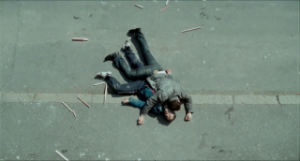Updates
'Five Minutes of Heaven': A Close Reading (part 2)

Halfway through the film, Little is sitting in the meeting room, waiting for Griffen. He begins to speak: ‘In order to talk about the man I have become…’. We realise that this is where the opening lines of the film are from. In this way, the film loops the narrative back again, moving us back towards the past within the present. As he speaks, we see Little in person and Little as seen on the camera’s monitor. We don’t yet know whether he is sincere or playing to the camera; and we perhaps question how valuable it is even if he is sincere. Again, screened narratives are placed under question: how valuable is framing this moment in the first place?
We hear ‘Cut’, and the film cuts to the TV show’s director and producers in chairs, with their own monitors (and they are intently watching the screens, not Little himself). The interruption again makes the narrative feel hollow, or at least constructed for repeated telling and for consumption yet again (‘The thing you have to understand is the mindset…’, he intones, while the monitors show him from different well-lit angles). The mic is ‘picking up noise’, a crew member points out – and we might ask, how much of the post-conflict narrative has just been ‘noise’? How much has been truly meaningful?
But Little does begin to explore the nature of the narrative at the time: ‘the mindset… it was only our people being killed…’. The camera pans slowly. ‘In my head it was the proper, just, and fair thing to do’. There has been an emphasis on heads so far in the narrative: Griffen’s brother was shot three times in the head; there have been long close ups of Little’s and Griffen’s heads as they have been seemingly lost in thought; the monitors on set frame the participants’ heads. In the film we move between the ‘heads’ (the respective mindsets) of the two men.
The camera comes to rest on a direct close-up, after moving between the monitors. Later, during the conversation between Griffen and the runner, we find out that Little’s apartment is ‘cold’, ‘empty’ – interiors of buildings stand for mindsets in the film. We could also note that the runner and Griffen are outside smoking on the balcony during the conversation. This is an in-between space where Griffen can find out information. Buildings are significant in the film as both standing for and enforcing institutional power (religious, historical, social etc.) and are thus instrumental parts of a conflict like this. They can both separate and unite groups.
This focus on buildings, on being trapped in one’s own ‘mindset’ and trapped in the past, will culminate in both men falling together outside the window of the abandoned house. This represents a painful but necessary escape from the trap of mindset (as Little notes at a therapy session: ’33 years that boy has been living in his head’. He means that Griffen himself, as a child, has been living inside Griffen’s head. Providing this commentary without context loops the narrative once again, so that Little again acts as narrator and simultaneously as commentator on a narrative he doesn’t necessarily have the right to control. Having said this, his critique appears to be accurate.
The arranged meeting doesn’t end up happening. Griffen is overwhelmed and becomes too distressed to either meet Little or to try to kill him. But the viewer is left with the implication that such a meeting, even if it had happened without violence, would have been a trite ending to the personal conflict, with a foregone affective conclusion demanded by the format: to culminate in a handshake (‘I know, I know what you fuckin’ want. Shake his fuckin’ hand and we can all go home’, Griffen muses to himself).
Little, walking through a Protestant estate, passes murals on his way to a pub. There, he meets a loyalist, released in the Good Friday agreement (‘and on top of the world. Still living it, just like he always was’) who is now a gangster controlling the estate (‘he’s killed a few Catholics in his time, and now he’s killing his own’). The Loyalist paramilitary narrative begins to feel hollow overall, not only as a personal issue for Little. Ideologues apparently became gangsters; in doing so, they prolonged the conflict, living in the violent past and profiting off it.
When Little goes to the Catholic pub in Lurgan to find Griffen, he finds men sitting silently in the dark. It is nearly empty. Like the Loyalists, these men could be said to be living in a conflict-post-conflict-state, where the past persists into the present. The pub – a traditional meeting place for an estate – is seen as bereft of any life or joy. An interior room is again representative of ‘mindset’ and an inability, or lack of desire, to move on. So many of the physical progressions in the narrative so far – Griffen in the chauffeur-driven car, Little in his own chauffeur-driven car, Little on the train to the pub – have been to ‘nowhere’. The characters, despite their travels around the region, still end up stuck and unable to move on emotionally.
At the culmination of the film is a fight between Griffen and Little at the latter’s abandoned childhood home. Both men fall together, in a moment that is both cathartic and which emphasises the mutual destructiveness of the conflict. The empty window frame of the dilapidated house frames a church across the road. This background image lingers after they fall: religion has been in the background of the conflict, and remains present, at least as a building (again, as a shell of a ‘mindset’). The camera zooms in on the church and its own windows. Its own series of frames are in a pattern of three, perhaps reminiscent of the repeating patterns of monitors from earlier in the film. The camera tilts downwards, in the same movement, to the two men, unconscious in each other’s arms.
While still on the ground, Little gives his post-conflict testimony. It is simultaneously a confession, in the legal and religious senses. He admits the pleasure he took in the aftermath of the killing. Griffen watches him silently, the church in the background of his shot: he has the authority now. But Little is then the one who gives Griffen some sort of atonement. There is a quasi-sexual feeling to the physical confrontation and climax – Griffen even smokes a post-conflict cigarette. His ‘five minutes of heaven’, such as it was, was not what he expected. By taking the ‘frames’ of the film from the city itself, rather than relying on the frame of the film itself, Five Minutes of Heaven could be said to move away representing its own representational values as authoritative.
The film cuts to Griffen’s wife and children in their home, watching TV. Griffen, however, is watching his family. Perhaps this implies that Griffen has finally begun to move on from the ‘screened’ narrative of the conflict and is instead becoming focused on the future. The film cuts to Griffen at a men’s group therapy session. He talks about how he ‘doesn’t know the [correct] words’ for the situation. He wants his daughters to be proud of him, he says – and he begins to sob: ‘that’s it…that’s out…’. He has finally begun to release what he has been holding in, and what killing, or the ‘five minutes of heaven’, would not necessarily have brought him.
Five Minutes of Heaven ends with Little, in the middle of the street, being ‘released’ from his own imprisoning mindset by Griffen (‘We’re finished’, he tells Little over the phone). Little, in the centre of a crossing, with a grand building in the background, collapses. The background building suggests that the imprisoning conflict will always be present, but that it can potentially be escaped. The final shot is from above, as Little gets up and walks off – away from the imprisoning ‘mindset’, the film implies. Like Griffen, he is, to some extent, no longer stuck in his head, or in Griffen’s head. The shot is notable not a close-up, and is mobile, not static. Little and Griffen have been in a forced intimate relationship for years, living in each other’s heads, and they now experience mutual release – they let go of each other.
Last modified: Sat, 28 May 2022 17:09:07 BST










